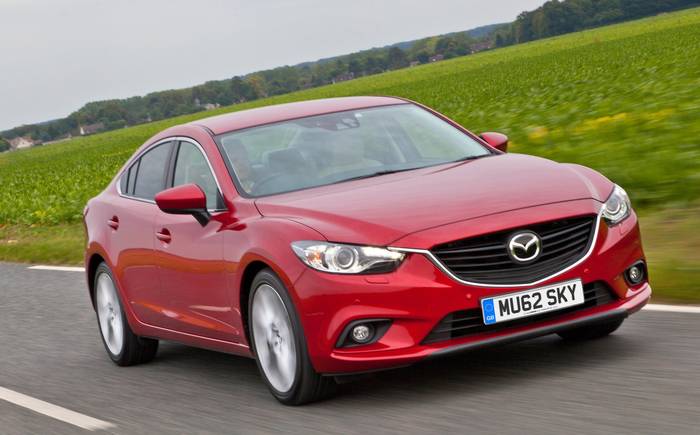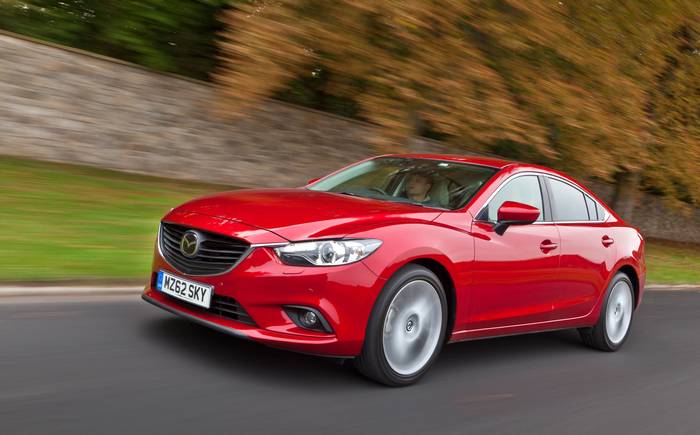Mazda 6 Mk 3 review (2013 on)
The Mazda 6 doesn’t just look good next to rivals such as the Vauxhall Insignia, Volkswagen Passat and Ford Mondeo ‒ it’s also good value,

What is the Mazda 6?
Mazda might have advertised its cars using the slogan “zoom zoom” but for years it has churned out a series of dull, slow-selling saloons and hatchbacks that have failed to stand out from the crowd. Its latest cars are designed to break the cycle, with stylish lines and advanced Skyactiv technology which is claimed to make the cars more fun to drive, while delivering class-leading fuel economy.
Search for and buy a used Mazda 6 on driving.co.uk
The Mazda 6 doesn’t just look good next to rivals such as the Vauxhall Insignia, Volkswagen Passat and Ford Mondeo. It’s also good value, with prices ranging from £19,595 for the petrol saloon to £27,445 for the diesel estate. Even the lowest-spec models have a push-button start, Bluetooth, cruise control and colour touchscreen.
Buyers have a choice of two 2-litre petrol engines, which deliver reasonable performance and excellent fuel economy of up to 51.4mpg. The story is even better for the two 2.2-litre diesels, the most economical of which returns 67.3mpg thanks to the SkyActiv features. These include the use of advanced steel to make the body lighter, redesigned engines that are lighter and more efficient and a mini hybrid system called i-Eloop. This converts energy lost while the car is slowing down or braking into electricity, which is stored in a capacitor. In stop-start traffic it can supply enough power to run windscreen wipers, air conditioning and lights for most of the time, helping to improve fuel efficiency.
The drive
Start driving in town and you begin to wonder whether the technology has, in fact, taken over completely. Coasting at low speeds in second gear, there’s little engine braking; it can feel like the car is driving by itself. At these speeds, the car crashes into potholes, instead of gliding smoothly over them. This can nudge the steering wheel, giving the impression that it is trying to steer itself. And then you pull up to a set of traffic lights and the engine cuts out. A message on the dashboard says “i-stop”: not a declaration of independence but the stop/start system in action.
As the speed increases the ride improves, the suspension smoothing out bumps and ridges. There’s none of the vibration that can be felt in slower traffic. The steering is precise and the gearlever slots from one ratio to another with a satisfying thunk, making the Mazda a comfortable but swift machine on B-roads and motorways. Here there’s always the temptation to take the petrol engine close to its 6,500 rev limit, where it emits a high-pitched yowl. Company car drivers, and anyone with a close eye on fuel bills, will choose the diesel engine which performs well and is eager to accelerate. The most powerful emits only 119g/km CO2, which means low car tax and company car tax rates.
The only issue with the car is its apparent size; the swoopy styling drops away at the front and sides, which makes it difficult for the driver to know exactly where it is on the road ‒ awkward when you’re driving through motorway road works in narrow lanes. In reality, at 1840mm wide, the 6 isn’t much bigger than its rivals. Visibility could be better; the steep A-pillars either side of the windscreen can obscure your view, so that you sometimes need to crane your neck at junctions. Rear parking sensors are also advised; judging when you’re about to back the boot lid into a wall is tricky without them.
The interior
It’s a comfortable place to be but more than a little bemusing thanks to the dashboard that’s littered with buttons, which mainly seem to do the same thing. Take the simple task of moving to the next track on the album you are listening to: all you need to do is press your finger over the forward button on the touchscreen. If, however, you prefer an old-fashioned button, you can press that instead ‒ it’s less than an inch away, right next to the screen. Alternatively, there’s also a “next track” button on the steering wheel but if none of those options takes you, then there’s the rotary controller behind the gearstick. Its sole job seems to replicate all of the other controls. Unfortunately, this button-mania has resulted in some even odder choices. Most functions can be controlled through the central menu system on the touchscreen. Except for the clock. You might imagine that the controls to adjust the time could be hidden in a sub-menu, but no, three ugly plastic horizontal buttons have been placed in the middle of the dashboard, so the driver can change the time on the clock without taking their eyes off the road.
The sat nav, supplied by TomTom, also feels dated with its bright pink and green graphics, which can often be misread, sending you in completely the wrong direction. Fortunately these flaws don’t outweigh the good points of the well-made cockpit, which does feel premium with soft plastics and mostly solid switchgear.
The one to buy
Mazda 6 2.2d Sport (175)
Factfile
- Price:
- £25,495 (correct at first publication)
- Engine:
- 2191cc 4-cylinder diesel
- Power:
- 173bhp @ 4500rpm
- Torque:
- 310 lb ft @ 2000rpm
- Transmission:
- 6-speed manual
- Acceleration:
- 0-62mph: 7.9sec
- Top speed:
- 139mph
- Fuel:
- 62.8mpg (combined)
- CO2:
- 119g/km
- Road tax band:
- C
- Dimensions:
- L 4870mm, W 1840mm, H 1450mm
Mazda 6 used car rivals for similar money





